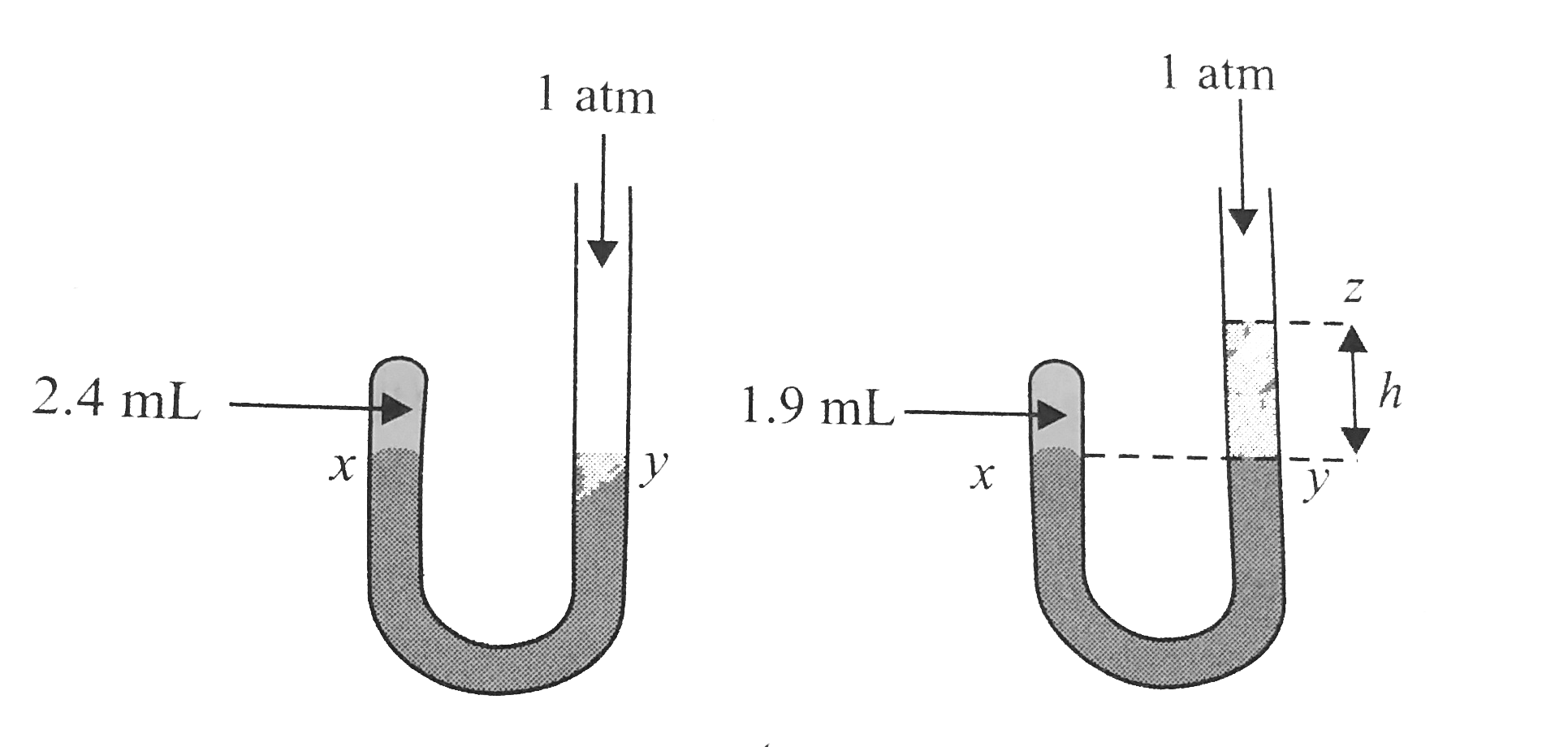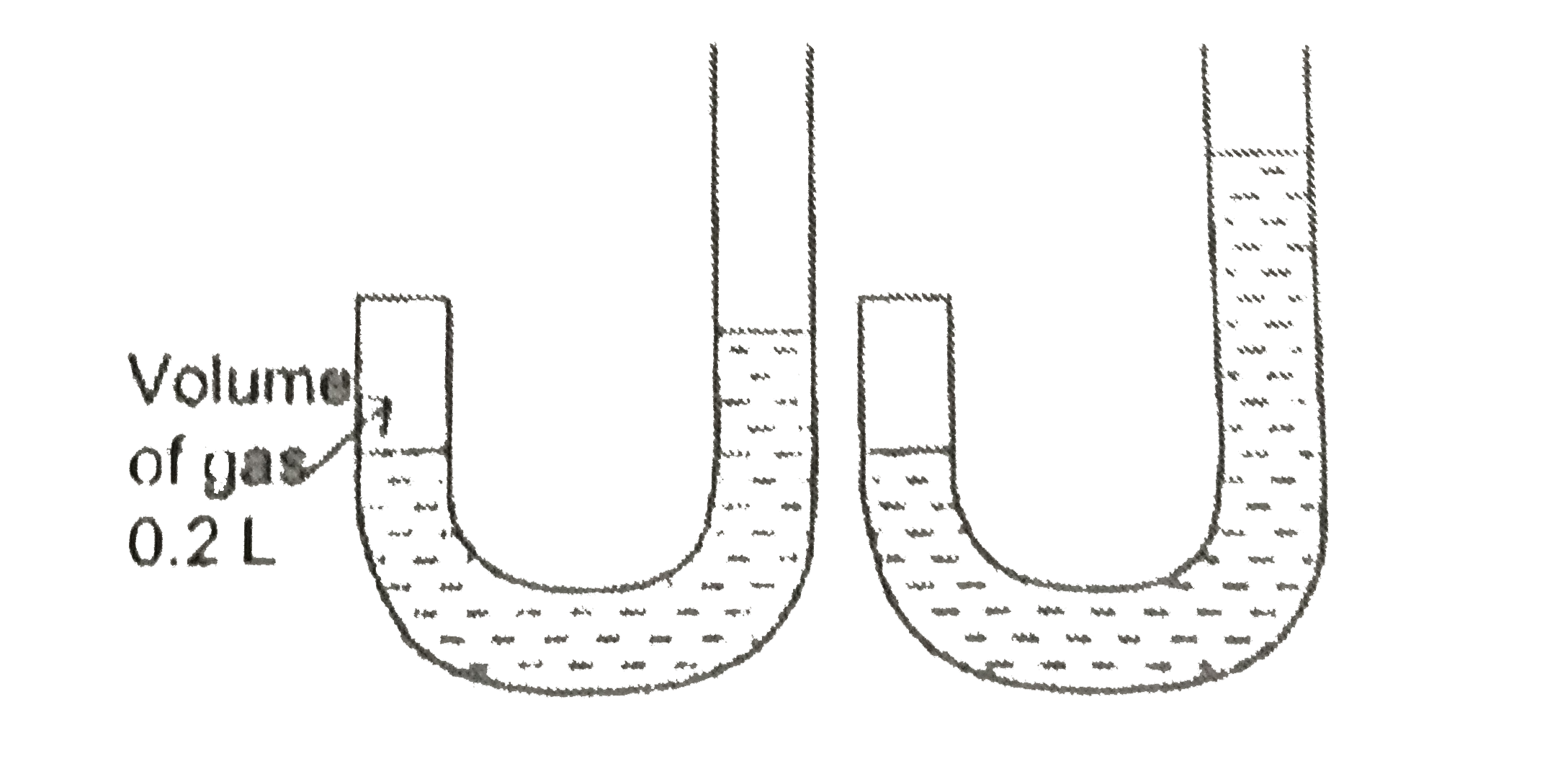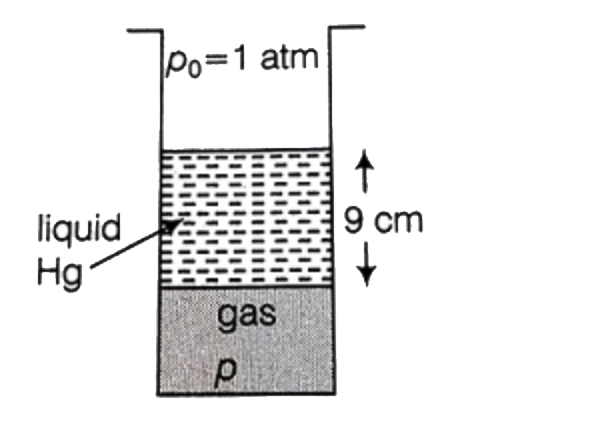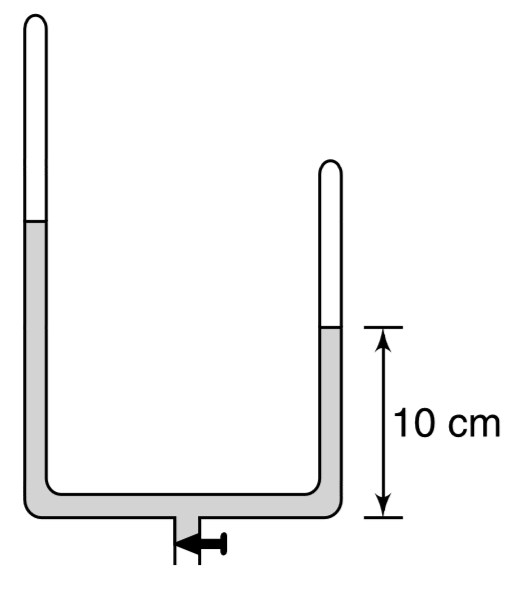Given J-tube has 2.4 mL of air at a pressure of 1 atm. On adding mercury, volume of air is reduced to 1.9 mL as shown. Difference in the level of mercury in two columns is:

(a)700 mm
(b)200 mm
(c )900 mm
(d)760 mm
The correct Answer is:B
Atmospheric pressure =76 mmHg
⇒P1V1=P2V2
P2=P1V1V2=760×2.41.9=960 mmHg
∴ Difference in column =960−760=200 mmHg
Topper's Solved these Questions
- MOCK TESTBOOK - A2ZCHAPTER - MOCK TESTEXERCISE - Mock Test 2
45 Videos
- IONIC EQUILIBIUMBOOK - A2ZCHAPTER - IONIC EQUILIBIUMEXERCISE - Section D - Chapter End Test
30 Videos
- P BLOCK ELEMENTS ( Group 13 -14)BOOK - A2ZCHAPTER - P BLOCK ELEMENTS ( Group 13 -14)EXERCISE - Section D - Chapter End Test
30 Videos
Similar Questions
J-shped tube closed at one end was used by Boyle to study the relationship between the pressure of the trapped gas and its volume. Such a set up is given here. Initially some amount of gas is taken in the tube and mercury is poured in it. The volume of the gas is 0.2 L and the difference in the height of the mercury column is 760 mm of Hg. Now, some more amount of mercury is poured and the difference in the height of the mercury column is found to be 1140 mm of Hg. Calculate the new volume of the gas considering the temperature constant.

View SolutionIn a constant volume gas thermometer, the pressure of the working gas is measured by the differenced in the levels of mercury in the two arms of a U-tube connected to the gas at one end. When the bulb is placed at the room temperature 27.00C, the mercury column in the arm open to atmosphere stands 5.00cm above the level of mercury in the other arm. When the bulb is placed in a hot liquid, the difference of mercury levels becomes 45..0Cm. Calculate the temperature of the liquid. (Atmospheric pressure =75.0cm of mercury).
View Solution
Knowledge Check
A J-shaped tube with smaller end closed and longer end open was taken. Mercury was added into it till the level of mercury in both the limbs was same. Volume of air enclosed in the closed end was found to be 2.4 mL. Now more mercury was added and the air enclosed in the closed ed reduced to 1.9 mL. Now, the difference in the level of the two limbs will be
A43 cmB5 cmC10 cmD20 cmIn the given figure, atmospheric pressure p0=1 atm and mercury column length is 9 cm. Pressure p of the gas enclosed in the tube is
 APressure of 67 cm of HgBPressure of 90 cm of HgCPressure of 78 cm of HgDPressure of 85 cm of Hg
APressure of 67 cm of HgBPressure of 90 cm of HgCPressure of 78 cm of HgDPressure of 85 cm of HgSuppose the pressure at the surface of mercury in as barometer tube is P1 and the pressure at the surface of mercury in the cup is P2.
AP1=0,P2= atgmospheric pressureBP1= atmosphereic pressure P2=0CP1=P2=atmospheric pressureDP1=P2=0
A U shaped tube has two arms of equal cross section and lengths l1=80 cm and l2=40 cm. The open ends are sealed with air in the tube at a pressure of 80 cm of mercury. Some mercury is now introduced in the tube through a stopcock connected at the bottom (the air is not allowed to leak out). In steady condition the length of mercury column in the shorter arm was found to be 10 cm. Find the length of the mercury column in the longer arm. Neglect the volume of the part of the tube connecting two arms and assume that the temperature is constant.

View SolutionA 1-L flask contains some mercury. It is found that at different temperature, the volume of air inside the flask remains the same. What is the volume of mercury in the flask, given that the coefficient of linear expansion of glass=9×10−6/∘C and the coefficient of volume expansion of Hg=1.8×10−4/∘C ?
View SolutionThe reading of a barometer containing some air above the mercury column is 73cm while that of a correct one is 76cm. If the tube of the faulty barometer is pushed down into mercury until volume of air in it is reduced to half, the reading shown by it will be:
View SolutionArrange the following steps in proper sequence to determine the pressure exerted by a gas enclosed in a container using a manometer.
(A) Connect one end of the manometer to the container filled with gas.
(B) Both the limbs of the manometer are exposed to air, mercury level in both the limbs are equal due to atmospheric pressure
(C) Determine the difference in level of the mercury in both the limbs of the manometer (t).
(D) If the level of the mercury in the limb connected to the container is above the mercury level in the limb exposed to air, the pressure of the gas in the container is determined as atmospheric pressure - l
(E) If the level of the mercury in the limb connected to the container is above the mercury level in the limb exposed to air, the pressure of the gas in the container is determined as atmospheric pressure +l
(F) Note the level of the mercury in the limbs of the monometer.
View SolutionArrange the following steps in proper sequence to determine the pressure exerted by a gas enclosed in a container using a manometer.
(a)Connect one end of the manometer to the container filled with gas.
(b)Both the limbs of the manometer are exposed to air, mercury level in both the limbs are equal due to atmospheric pressure.
(c )Determine the difference in level of the mercury in both the limbs of the manometer (l).
(d) If the level of the mercury in the limb connected to the container is above the mercury level in the limb exposed to air, the pressure of the gas in the container is determined as atmospheric pressure -l.
(e ) If the level of the mercury in the limb connected to the container is below the mercury level in the limb exposed to air, the pressure of the gas in the container is determined as atmospheric pressure +l.
(f) Note the level of the mercury in the limbs of the manometer.
View Solution
